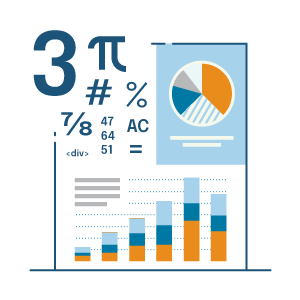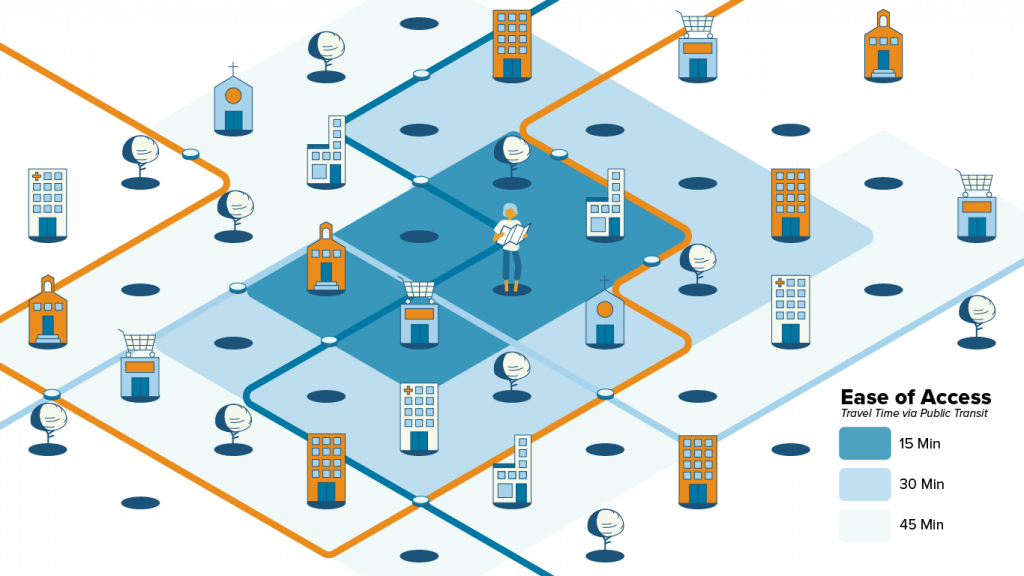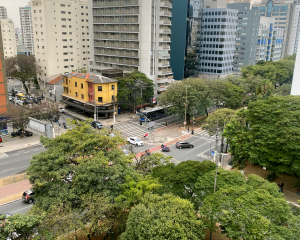
Let’s Take The Bus
How can we change the car-dependent culture in the US?
In the United States, more than half of all trips taken are less than five miles long (source FHWA, 2022). It makes sense that many short trips could easily be done via active transportation (like walking and biking) or public transportation. So why are cars such a large part of our culture?

Buses vs. Cars
The short answer is that the car industry and car-related road infrastructure has been prioritized historically, while infrastructure supporting active and public transportation has not been – often making the latter inconvenient, inconsistently available and unsafe.
Personal vehicles are preferred over public transit in the US because they are, or are perceived to be, more convenient to use, offer better access to needed locations and take less time to travel. DCR believes cities should pay attention to these reasons when planning and prioritizing future transit infrastructure. Climate, sustainability and social equity improvements have also become forefront issues for cities, where better multi-modal transportation options can improve the quality of life for everyone.
Changing The Culture
Late last year, the National Association of City Transportation Officials (NACTO) published a useful resource titled Move! That! Bus! which DCR wants to share a few thoughts about. Our takeaways are below, and we encourage you to read the full document.
Key Takeaways
Proactive cities can change the transit habits of their citizens within just a few years by adopting these three actions:
- Offer frequent, all-day bus service.
- Redesign streets to prioritize bus service, including access to the bus network.
- Adopt local policy reforms that support transit.
Bus service improvements are relatively cheap and quick to implement compared with more glamorous train rail infrastructure. Transit agencies and city transportation departments can work together to prioritize the development and implementation of a network that best serves their region.
Prioritizing Access Over Profit
When bus routes are being created, it’s important to look at access metrics for each region – this is done by analyzing local socioeconomic data alongside the number of destinations available within a 15-45 minute bus trip. (See the graphic below.)

Older models of bus transit planning prioritize the needs of 9-5 commuters to reach office locations and their homes – but statistically speaking, around 84% of trips taken are not commuting related and instead connect riders with a range of destinations including stores, schools, hospitals, and recreation and entertainment spaces (source FHWA 2022). The trends of the past few years have further reduced commuters’ use of transit, meaning the priorities of effective transit planning need to adapt to modern travel and community needs.
Rather than focusing “…on the number of riders or revenue generated, access metrics… [show] how useful transit is to the people it serves.” (Move! That! Bus! Pg. 14). When planning agencies prioritize access metrics, rather than productivity/profit metrics, they can ensure that riders all over the region benefit from public transit.
Be A Part Of Implementing These Changes
DCR emphasizes that real change can be made towards reducing car journeys and improving our climate, sustainability and equity goals by implementing high frequency, more accessible public transportation. We also emphasize a few related points towards effective and successful implementation of public transportation improvements:
- Transit riders are also pedestrians and/or bicyclists (other rollers as well). Improvements to bus infrastructure also need to address the access to stop, stations and final destinations.
- Safe walking and biking conditions are critical for safe access and usage of transit.
- Marketing and communication with the public is critical in achieving both effective plans, early adoption and successful usage of an improved transit system.
DCR provides expertise in developing transportation plans and graphic communication to help transit riders understand their travel options. We welcome continuing this conversation with you!

Want to work with us? Feeling inspired?
Contact us at info@dcrdesign.net or checkout our social medias: LinkedIn, X and Instagram
For more information visit:
Vision Zero, Safe systems approach and NHTSA




